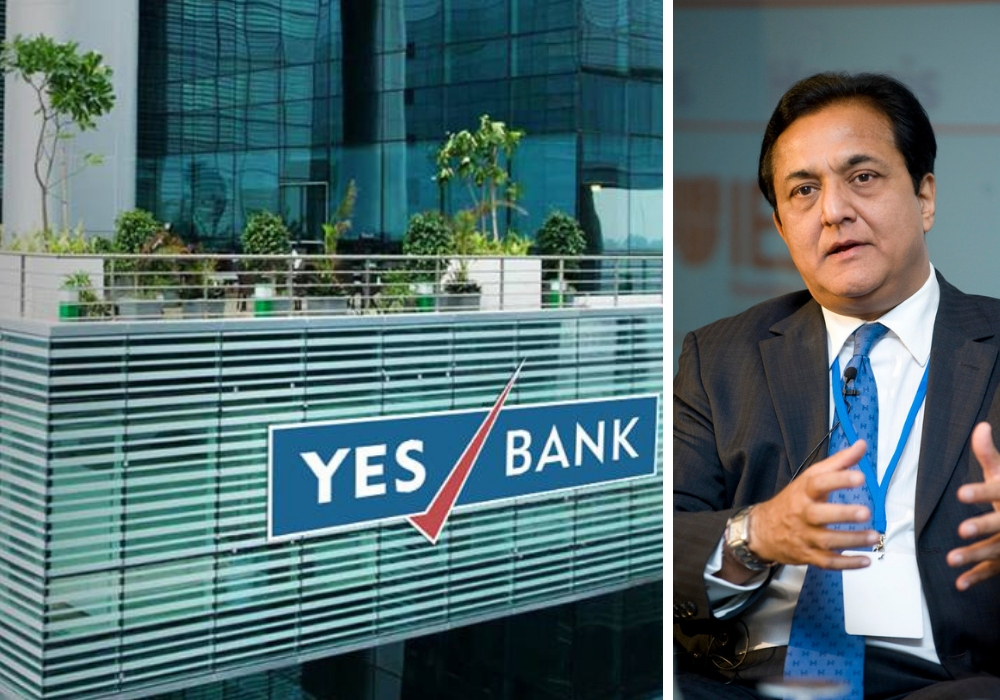[Photo of YES Bank, via Facebook (cropped from original); Photo of Rana Kapoor by Richter Frank-Jurgen (cropped from original) under Creative Commons]
Most former colleagues at Deutsche Bank (DB) are still a bit perplexed at Ravneet Singh Gill’s decision to cross over from the quintessential German multinational bank to one of India’s most troubled private sector banks as its new CEO and MD. After six years at the helm at DB, Gill had already developed a good reputation as a straight shooter, who liked playing by the rules. Unlike his more flamboyant predecessor Gunit Chadha, he preferred to stay decidedly low key. Clearly, Gill may not have set the Ganges on fire during his tenure at DB. But he pursued a steady, conservative approach, with a record of the lowest NPAs (nonperforming assets) in the banking industry. By all accounts, that went down well with the Reserve Bank of India (RBI).
There is one primary reason why Gill may have chosen to pitchfork himself into the perfect storm that’s playing out at India’s fourth largest private sector bank. The new assignment offers him a far bigger and exciting platform, to not just bring the bank back on the rails, but also take it to the next level. YES Bank’s stock price has more than halved in the last six months, in sync with the flurry of bad news surrounding the bank. So if Gill can pull off the hugely challenging task, there could be a large pot of gold waiting at the end of the rainbow.
There’s little doubt that Gill would know fully well what he is stepping into. After all, for the past several months, YES Bank has been in the eye of the storm that’s gripped the banking and financial services sector. And clearly, there’s plenty more to come. Its tangles with the RBI have made front page news. For two years in succession, RBI’s estimates of NPAs based on its inspections have been at sharp variance with the bank’s own.
That’s why RBI’s upcoming divergence report will have serious implications for the bank, given just how much pressure the stock has been under. In various roadshows in Singapore and elsewhere, analysts say that Rajat Monga, the bank’s executive director and promoter and former CEO Rana Kapoor’s trusted right hand man, has maintained the divergence would be in the region of Rs 1,500-1,800 crore. The RBI inspection at YES Bank is now complete. And market speculation suggests that the actual number could be much higher than what the bank suggests. The RBI report is likely to be shared with the new CEO when he joins and the final number could emerge once the bank’s fourth quarter results are presented.
The resignation of two directors on the board, including chairman Ashok Chawla and independent director R Chandrashekhar, didn’t inspire confidence. Plus, there was considerable chatter about the sudden exit of OP Bhatt as well. In a regulatory filing, the bank said that Bhatt, who was an external expert on the Search and Selection Committee (S&SC) for the new CEO, resigned with “immediate effect” as “there may be a potential conflict of interest”. Why Bhatt was chosen on this search committee when he already served on the board of rival Standard Chartered Bank Plc is inexplicable.
Besides, the bank’s high exposure to real estate and infrastructure clients, namely DHFL (analysts estimate the exposure to DHFL alone to be about 15% of the bank’s net worth), IL&FS and Indiabulls, among a few others, will continue to be a cause for concern, especially if things head further south with these borrowers.
A little more than a week ago, Gill was introduced to the senior leadership at the bank by Kapoor. In that emotion-laden meeting, Kapoor took pains to stress on the fact that he remained the single largest shareholder in the bank.
Even while insisting that he resign as CEO, the RBI hasn’t yet clarified whether Kapoor will be allowed to continue on the board. The articles of association at the bank state that he is entitled to a non-retiring board seat. If RBI allows him to continue on the board, it could create a piquant situation. After all, if he wasn’t found fit and proper to continue as CEO, how would RBI justify its decision to make him a custodian of the bank’s stakeholders on the board?
The patch-up between the two warring factions (Rana Kapoor and the widow and daughter of his late partner Ashok Kapur who set up the bank) in the promoter group has provided at least a semblance of stability.
Managing the cross-over
Gill’s biggest challenge will be to gradually overturn Kapoor’s unique, highly centralised leadership style
Gill’s biggest challenge will be to gradually overturn Kapoor’s unique, highly centralised leadership style. Kapoor’s 30-member corporate centre would function out of a separate office in Worli in Mumbai. And his leadership team is based in Lower Parel, a couple of kilometres away. Despite that, Kapoor would keep himself abreast of every key development, especially on the corporate loan book. Even during the height of the crisis, Kapoor seldom met his team face-to-face. Insiders say he puts in punishing hours at work, remaining accessible round the clock on WhatsApp. Veteran retail banker Pralay Mondal, who is said to be transitioning to Axis Bank shortly after a six-year term, is said to have had barely two formal face-to-face internal meetings with Kapoor during his entire tenure at YES Bank. Over time, YES Bank’s leadership grew accustomed to their CEO taking all the major calls.
It isn’t the first time that a multinational banker is attempting a cross-over to a private sector bank. For instance, Bank of America’s Vishwavir Ahuja took over the reins at RBL in 2010, after nearly 18 years at Bank of America. In 1994, Aditya Puri was handpicked to set up HDFC Bank after a long career at Citibank and went on to turn it into India’s biggest private sector bank.
But it isn’t without its own set of challenges. A senior banker who spent his entire career with a MNC bank, recently joined a leading Indian private sector bank, only to quit in less than a year. He says that it took some time to get used to the prevailing risk culture inside. “When I joined the Indian private sector bank, I found there were more than 800 audit issues pending. That amazed me because in my previous assignment, even if there were two audit issues that hadn’t been closed, we’d be fretting and fuming about it and doing everything to close them,” he says. Perhaps, the top leadership team at the private sector bank wasn’t willing to sacrifice its focus on business delivery, and had taken a call that the audit risks aren’t material, he says.
There’s a structural issue at play as well. In foreign banks, the head of risk typically has a dotted line relationship with the country head. But to give the role adequate independence from an all-powerful CEO, the country risk head also has a solid line relationship with the head of risk in the region. It is then incumbent on the board at private sector banks to provide the head of risk adequate risk cover.
However, it isn’t as if foreign banks have had it any better. They too have had their own share of blowouts. Take DB, HSBC and Standard Chartered Bank. Each of them had to effect CEO changes in recent years and initiate costly corrective action.
On their part, the smaller Indian private sector banks like YES Bank, have had to focus on riskier borrowers, compared to the Triple A rated borrowers, whom every bank flocks to. Since their cost of funds tend to be somewhat higher than the larger banks like HDFC Bank, ICICI Bank and SBI, these smaller banks have to look for higher yield from their corporate loan book. And that forces them to look at real estate and infrastructure clients who are willing to pay a higher interest.
In YES Bank’s case, insiders say that Kapoor’s skill lay in smartly structuring these loans and in many cases, demanding collaterals to protect himself, in the event the borrower faced stress. Plus, it took plenty of guile and chutzpah to get errant clients to pay up, without entirely losing the relationship.
It remains to be see if Gill is able to carry out that fine balancing act. A former colleague at DB says that he wouldn’t hesitate to pull the plug and unwind his position, if a client missed a couple of payment deadlines.
Not a pushover
At that same meeting where Gill was introduced, many insiders went back expecting that status quo might prevail. Their assumption: the incoming CEO would manage key stakeholders, but leave Kapoor’s trusted lieutenant Rajat Monga and a few others to handle the dirt and the grime.
However, Gill’s former DB colleagues say nothing could be further from the truth. Gill is not one to suffer fools easily. Unlike his predecessor Chadha who preferred to take people along, Gill would provide direct feedback to colleagues if he wasn’t happy with their performance or their attitude. He could be blunt and not be hung up on niceties. And if there was one thing that most people say about Gill: he has strong likes and dislikes. And once he makes up his mind about a person, it is hard to get him to change his opinion.
Former DB colleagues say that he might take six months to settle down and understand the lay of the land at YES Bank. After that, he will most certainly come into its own.
Clearly, Kapoor and Gill seem like chalk and cheese. It remains to be seen whether they are able to form a working relationship, where Gill informally keeps his promoter informed about all major decisions beforehand.
Kapoor will need to make this new arrangement work—a significant part of his family’s stake in the bank is pledged
There is one reason why Kapoor will need to make this new arrangement work. A significant part—some say in the region of 60-70%—of his family’s stake in the bank is pledged. That money was used by the family to invest in many unrelated areas like education, retail and media.
And it is in his interest to give Gill the space he needs to make a difference. Or else, he could see his wealth evaporate, much like Zee’s Subhash Chandra, Jet Airways’ Naresh Goyal and many others.


Ravi Thota on Feb 17, 2019 6:38 p.m. said
V Ahuja 28 yrs at Bank of America before RBL Bank in 2010